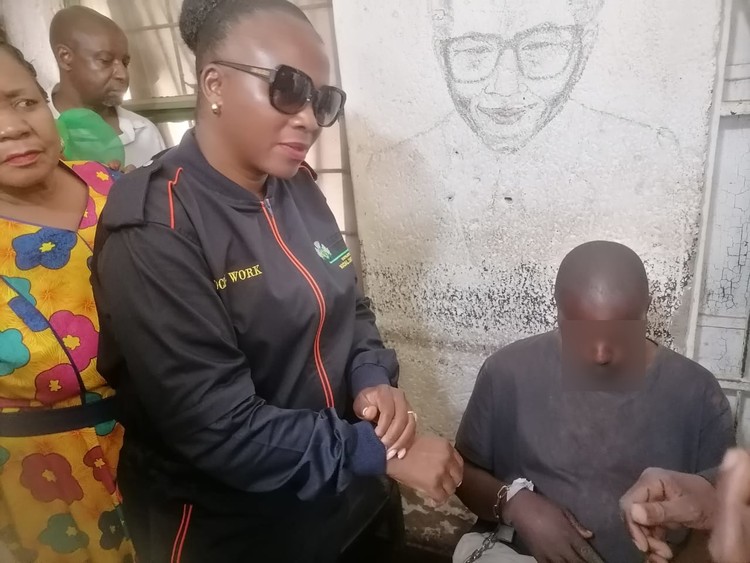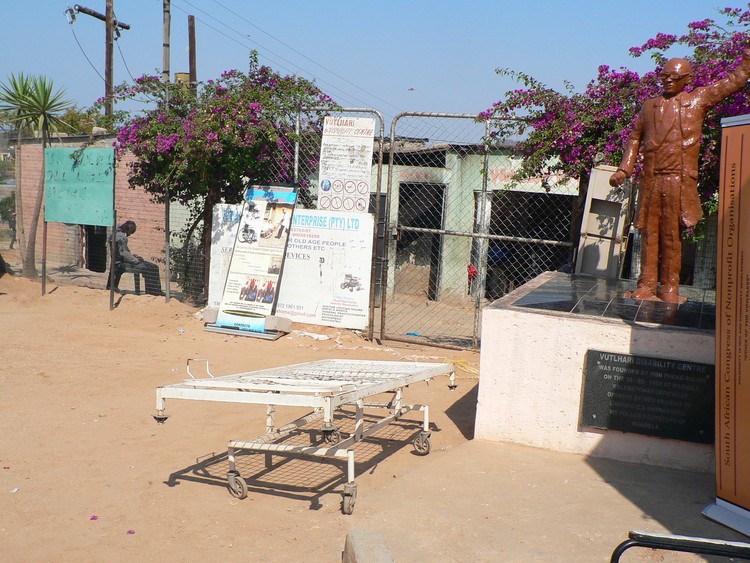People found chained at a private care centre
Department of Social Development is busy relocating the facility’s 20 occupants amid allegations of neglect and inhumane conditions
One of the two people living at Vutlhari care centre for disabled and elderly people who were found chained at the facility when Limpopo MEC for Social Development Florence Radzilani visited this week. We have blurred the man’s face. Photos: Bernard Chiguvare
Two people in the care of a private care centre in Roerfontein, outside Tzaneen were found chained by their hands and feet during a visit by the Limpopo MEC for Social Development Florence Radzilani this week.
She led a delegation of officials to visit the privately run Vutlhari Old Age home and hospice for disabled and elderly people following serious allegations of neglect and inhumane living conditions. The issue was first brought to light after the Conty Lebepe Foundation went to the center in August after complaints from residents living nearby.
When MEC Radzilani questioned the facility owner on why the patients had been shackled, she was told that they were violent and chaining them was the only way to manage their care.
During the visit, the MEC revealed that the home had been operating unlawfully and called for it to be shut down immediately. Now social workers and officials at the Limpopo Department of Social Development are working around the clock to reunite many of these people with their families. Patients whose families cannot be found will be relocated to other accredited facilities.
A broken hospice bedframe at the entrance to the facility.
“If by any chance any family is not able to receive their loved ones the department will relocate the individual to relevant centres,” said Joshua Kwapa, department spokesperson.
Andani Netshifamadi, 31, from Ha Mangilasi village in Vuwani is one of the 20 people at the centre. “I am wondering what is going on with my disability grant for the past two years. The owner of this centre is holding my South African Social Security Agency (SASSA) card,” he told GroundUp. “We do not get enough food and at times I need to buy food for myself but cannot access my SASSA card.”
Relatives and community members told GroundUp that the living conditions at the centre are appalling. “My relative has been there for months, and we discovered that the residents are not being fed properly. The entire facility is a threat to human lives. We urgently asked the department to intervene and relocate them to other centres,” said a relative who asked not to be named.
The facility is visibly dilapidated with nearly all of the windows broken, missing ceiling boards and exposed electrical wiring in some rooms. There are nine rooms including a kitchen and a storeroom. Some of the beds we saw are broken and falling apart. There are two outside pit toilets with broken doors. Both were very dirty.
Pheko Baloyi said he started the organisation in 1998. Baloyi claimed to have all the necessary documents to operate legally. However, the department revealed that it stopped funding the facility back in 2016 when Baloyi failed to account for the funding he had received from the department.
Baloyi admitted that he was not feeding people enough because he couldn’t afford to. He said he relied on donations and the patients social grants to pay for the centre’s expenses. He claimed to have gotten consent from some of the patients’ families to do this but could not immediately provide proof of this.
Pit toilet used by elderly and disabled people living at the facility.
Support independent journalism
Donate using Payfast

Next: The health and economic costs of emissions at Kusile power plant
Previous: 31 years into democracy and the bucket system isn’t going away any time soon
Letters
Dear Editor
These animals that are supposed to take care of these poor people need to been sent to prison for what they are doing to helpless people. It is inhumane to treat people like this. Let the inmates teach them a couple of lessons for their involvement of this terrible treatment. Since when do they get paid a salary for treating people so badly?
Dear Editor
Absolutely not only very disturbing, but so much more disgusting, that anybody would ever think to be so totally inhumane! I cannot believe what I have just read! Shame on you all, indeed! May you be treated in the same inhumane, disgusting, extremely upsetting way one day when you also reach that very vulnerable stage!
© 2024 GroundUp. This article is licensed under a Creative Commons Attribution-NoDerivatives 4.0 International License.
You may republish this article, so long as you credit the authors and GroundUp, and do not change the text. Please include a link back to the original article.
We put an invisible pixel in the article so that we can count traffic to republishers. All analytics tools are solely on our servers. We do not give our logs to any third party. Logs are deleted after two weeks. We do not use any IP address identifying information except to count regional traffic. We are solely interested in counting hits, not tracking users. If you republish, please do not delete the invisible pixel.



